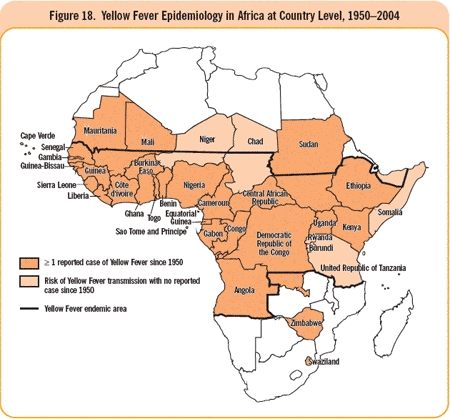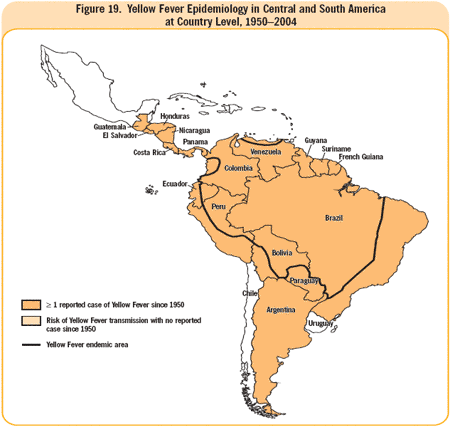Common menu bar links
Institutional links
Diseases & Conditions
Health & Safety
Research & Statistics
Agency Information
Search Box
E-mail this page
Vaccine-Preventable Diseases
Yellow Fever
Yellow fever (YF) is a zoonotic hemorrhagic fever caused by a flavivirus transmitted by Aedes aegypti mosquitoes. YF evolves though a spectrum of three periods of illness, from a non-specific febrile illness with head-ache, malaise, weakness, nausea and vomiting, through a brief period of remission, to a hemorrhagic fever with gastroin testinal tract bleeding and hematemesis, jaundice, hemorrhage, cardiovascular instability, albuminuria, oliguria and myocarditis. There is a 20% to 30% case fatality rate.
YF is a quarantinable disease subject to international health regulations. It must be reported to the World Health Organization (WHO) within 24 hours through the Travel Medicine Program of the Public Health Agency of Canada (PHAC). The Program must be contacted immediately in the event of a suspected YF case, at telephone number: (613) 941-6195. After hours, contact the PHAC duty officer on call, at telephone number: 1-800-545-7661.
Epidemiology
YF is endemic in the tropical areas of equatorial sub-Saharan Africa, Panama in Central America and the tropical region of South America (see Figures 18 and 19). It does not occur in Asia, although the vector, Aedes aegypti, is present there. Many countries have endemic Aedes mosquitoes but do not have the virus. They are able, by means of the international health regulations, to request proof of YF immunization as a requirement of entry.
Worldwide, 90% of YF cases occur in Africa and 10% in the Americas. The disease manifests itself in two epidemiologic forms, the urban and the sylvatic or jungle, both forms caused by the same virus. Urban outbreaks occur as a result of transmission by A. aegypti, which is widely distributed throughout the tropics. Urban disease is a particular problem in Africa and a potential problem in South America. Jungle YF is a disease transmitted by tree-hole breeding mosquitoes (Haemogogus mosquitos) to monkeys in the forests of South America and Africa, and can be transmitted to humans.
A recent resurgence of YF in certain countries prompted the WHO to include YF vaccine routinely within the Expanded Program on Immunization.
Disease control includes protection from Aedes mosquitoes, which are primarily day-biting, elimination of A. aegypti from urban areas and immunization of those at risk of exposure. Unimmunized Canadians can acquire YF when travelling abroad but cannot transmit the disease on their return to Canada, since the recognized mosquito vectors are not present in this country.
Since 1996 there have been reports of YF occurring in American and European travellers visiting YF endemic areas of Africa and South America. Notably, none of these tourists had received YF vaccine. There have been no cases of YF reported to the PHAC since surveillance began in 1924.
Source: WHO. On-line map at http://www.who.int/csr/disease/yellowfev/impact1/en/. Reprinted with permission.
Source: WHO. On-line map at http://www.who.int/csr/disease/yellowfev/impact1/en/. Reprinted with permission.
Source: Canadian Immunization Guide, 7th edition, 2006
Links to more information
Guidelines and Recommendations
- For information about Yellow Fever vaccine, see the Canadian Immunization Guide, 7th edition 2006
Travel Medicine Program


